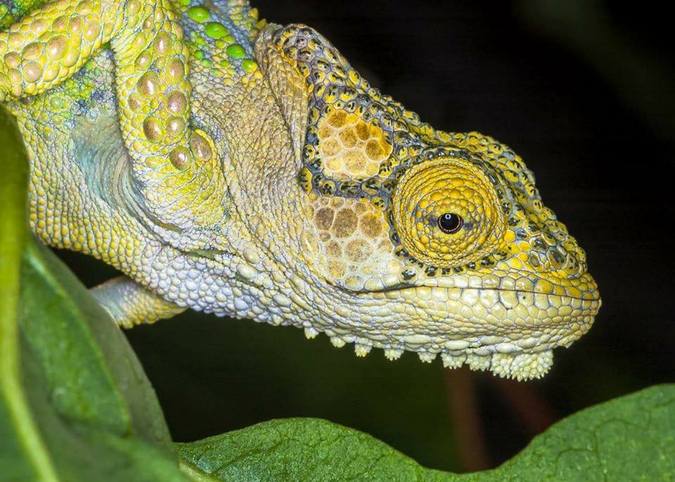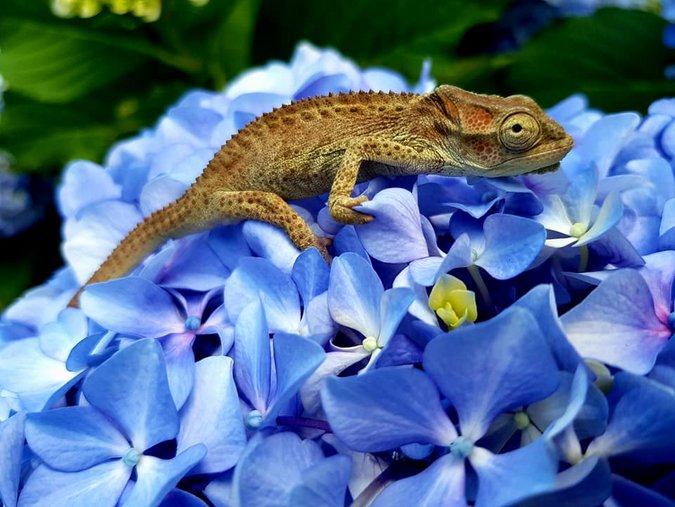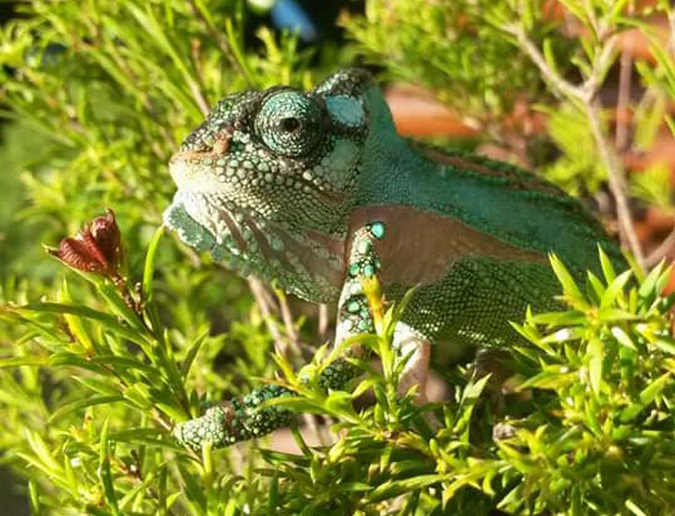
Written by Noelle Oosthuizen
After the fire in Knysna, in South Africa, there was so much devastation for everyone to consider. People had to salvage what they could, start rebuilding their homes, and continue to work hard to prevent further flare-ups. And in the midst of the chaos there were some conservation-minded folks who had yet another urgent question on their minds: where were all the chameleons?
The Knysna dwarf chameleon (Bradypodion damaranum) is a species of chameleon that is endemic only to that area. With no defence against the fast-moving fire, it is highly unlikely that any chameleons survived in the areas that were burnt. There is a small pocket of remaining indigenous forest that serves as the last refuge for the chameleons, along with suburban gardens – but this man-made landscape holds many dangers the chameleons aren’t prepared for, from hedge trimmers and garden shears to domestic cats and crows. Life for the urban-dwelling chameleon is a peril-filled affair.
Luckily for them, a small team of dedicated individuals have set out to change the fate of these unique creatures. Knysna resident, Aldo Kleyn, had already set up a successful chameleon-breeding project before the fire, but sadly lost 17 breeding pairs when his house burnt down. Now, in the aftermath of the fire, Aldo is rebuilding his sanctuary. He is also lending his support to Alex, Jezebel and their team from Garden Route Guardians (a community-based environmental organisation), who are working to expand this model of chameleon conservation by creating a network of guardians.
Signing up to be a guardian means committing to having a small sanctuary set up in your garden, that will house a breeding group of chameleons. Each breeding group consists of 1 male and 5-6 females, and the older the female, the more babies she births in every litter. While becoming a chameleon breeder may sound like a novel idea, the program is strictly monitored, with check-ups conducted on a regular basis.

It is also important to note that this breeding scheme does not require any chameleons to be removed from the wild. Instead, in the dark of the night, these wildlife rebels head out to prospective building sites, armed with flashlights, and gather up all the chameleons they can find. When day breaks construction will begin, which means certain death for any chameleons or other small creatures left behind. The reason these hunts are carried out at night is that chameleons are much easier to spot with a flashlight. All the chameleons rescued are taken back, and either paired up and placed in a breeding sanctuary or released into a chameleon-friendly garden.
Despite being nicknamed ‘slow foot’, these little creatures make use of around seven gardens as their home territory. For this reason, the team is encouraging residents to set up chameleon corridors, whereby an entire row of houses commits to keeping their gardens chameleon friendly. These wildlife corridors prove especially vital on the urban edge, allowing chameleons to move safely from the gardens to the indigenous forest and back again. Another advantage to having your neighbours on board is that it ensures that when ‘your’ chameleons climb over the fence, there isn’t a pet cat or a lawnmower waiting for them.

If enough guardians volunteer their backyards, the breeding project has the potential to make a real impact for the chameleon population. As it stands the Knysna dwarf chameleon is listed as least concern, on the IUCN Red List, but there has not yet been a re-count after the fire. With very little scientific population data available, the breeding program may seem like a cautionary measure. But it is very possible that it ends up being the reason this species is able to bounce back. The vision is that roughly a thousand young chameleons from the breeding program will be released back into the nature reserve every year. The babies are kept in the sanctuaries and only released back into the wild when they are bigger and have a better chance of survival. It is unlikely all thousand will survive, but even just 100 survivors would mean a boost for the population.
A few weeks ago three new chameleon babies were born. No bigger than a R5 coin at birth, it will take a while before they are big enough to be released. The Knysna Dwarf Chameleon Project is currently awaiting permits from Cape Nature before the first release can take place.
For me, there are two factors that set this project apart from a lot of other species preservation projects. Firstly, it allows individuals to be actively involved in a breeding program, and secondly, it makes use of a local solution for a local problem. This is just the beginning for the Knysna Dwarf Chameleon Project, but I believe it marks an exciting turning point for the little slow-foots.
GET INVOLVED
If you want to become a chameleon guardian, create a chameleon-friendly garden, or volunteer to help with the rescues, get in touch with Alex.

To comment on this story: Login (or sign up) to our app here - it's a troll-free safe place 🙂.![]()






